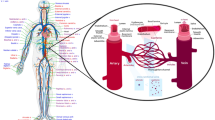Abstract
The Karlsruhe Heart Model (KaHMo) is a patient-specific simulation tool for a three-dimensional blood flow evaluation inside the human heart. Whereas KaHMo MRT is based on geometry movement identified from MRT data, KaHMo FSI allows the consideration of structural properties and the analysis of FSI. Previous investigations by Oertel et al. have shown the ability of KaHMo to gain insight into different intra-ventricular fluid mechanics of both healthy and diseased hearts. However, the in vivo validation of the highly dynamic cavity flow pattern has been a challenging task in recent years. As a first step, the focus of this study is on an artificial ventricular experiment, derived from real heart anatomy. Fluid domain deformation and intra-ventricular flow dynamics are enforced by an outer surface pressure distribution. The pure geometrical representation of KaHMo MRT can now be complemented by constitutive properties, pressure forces, and interaction effects using KaHMo FSI’s partitioned code-coupling approach. For the first time, fluid domain deformation and intra-ventricular flow of KaHMo FSI has been compared with experimental data. With a good overall agreement, the proof of KaHMo’s validity represents an important step from feasibility study toward patient-specific analysis.













Similar content being viewed by others
References
Baccani, B., F. Domenichini, and G. Pedrizzetti. Model and influence of mitral valve opening during the left ventricular filling. J. Biomech. 36:335–361, 2003.
Cheng, Y., H. Oertel, and T. Schenkel. Fluid-structure coupled 3D CFD simulation of the left ventricular flow during filling phase. Ann. Biomed. Eng. 33(5):567–576, 2005.
Janoske, U., G. Silber, R. Kröger, M. Stanull, G. Benderoth, T. Schmitz-Rixen, T. J. Vogel, and R. Moosdorf. Fluid-structure interaction in abdominal aortic aneurysms. 7th MpCCI User Conference, 2006.
Jones, T. N., and D. N. Netaxas. Patient-specific analysis of left ventricular blood flow. Comput. Sci. 1496:154–166, 1998.
Jung, B. A., B. W. Kreher, M. Markl, and J. Hennig. Visualization of tissue velocity data from cardiac wall motion measurements with myocardial fibre tracking: principles and implications for cardiac fiber structure. Eur. J. Cardiothor. Surg. 29(1):158–164, 2006.
Kilner, P.J., G.-Z. Yang, A. J. Wilkes, R. H. Mohiaddin, D. N. Firmin, and M. H. Yacoub. Asymmetric redirection of flow through the heart. Nature 404:759–761, 2000.
Krittian, S. Modellierung der kardialen Strömung-Struktur-Wechselwirkung. Dissertation, Institute for Fluid Mechanics, University of Karlsruhe (TH), Germany, 2009.
Krittian, S., U. Janoske, H. Oertel, and T. Böhlke. Partitioned fluid solid coupling for cardiovascular blood flow: left-ventricular fluid mechanics. Ann. Biomed. Eng. doi:10.1007/s10439-009-9895-7. ISSN:0090-6964 (Print) 1573-9686 (Online), 2010.
Liepsch, D., G. Thurston, and M. Lee. Studies of fluids simulating blood-like rheological properties and applications in models of arterial branches. Biorheology 28(1–2):39–52, 1991.
Long, Q., R. Merrifield, G.-Z. Yang, X. Y. Xu, P. J. Kilner, and D. N. Firmin. The influence of inflow boundary conditions on intra left ventricle flow predictions. J. Biomech. Eng. 125:922–927, 2003.
Michael, M., A. Harloff, T. A. Bley, M. Zaitsev, B. Jung, E. Weigang, M. Langer, J. Hennig, and A. Frydrychowicz. Time-resolved 3D MR velocity mapping at 3T: Improved navigator-gated assessment of vascular anatomy and blood flow. J. Magn. Reson. Imag. 25(4):824–831, 2007.
Oertel, H., S. Krittian, and K. Spiegel. Modeling the Human Cardiac Fluid Mechanics, 3rd ed. Karlsruhe University Press, 2009.
Pedrizzetti, G., and F. Domenichini. Nature optimizes the swirling flow in the human left ventricle. Phys. Rev. Lett. 95(10):108101, 2005.
Penrose, J. M. T., and C. J. Staples. Implicit fluid-structure coupling for simulation of cardiovascular problems. Int. J. Numer. Methods Fluids 40:467–478, 2002.
Saber, N. R., N. B. Wood, A. D. Gosman, R. D. Merrifield, G. Z. Yang, C. L. Charrier, P. D. Gatehouse, and D. N. Firmin. Progress towards patient-specific computational flow modelling of the left heart via combination of magnetic resonance imaging with computational fluid dynamics. Ann. Biomed. Eng. 31(1):42–52, 2003.
Schenkel, T., M. Malve, M. Reik, M. Markl, B. Jung, and H. Oertel. MRI based CFD analysis of flow in a human left ventricle. Methodology and application to a healthy heart. Ann. Biomed. Eng. 37(3):503–515, 2009.
Spiegel, K. Strömungsmechanischer Beitrag zur Planung von Herzoperationen. Ph.D. thesis, Institute for Fluid Mechanics, University of Karlsruhe (TH), 2009.
Spiegel, K., T. Schmid, T. Schenkel, and H. Oertel. Validierung des Karlsruher Herzmodells (DFG-Projekt OE 86/24-1). Technical report; Institute for Fluid Mechanics, University of Karlsruhe (TH), 2008.
Walker, P. G., G. B. Cranney, R. Y. Grimes, J. Delatore, J. Rectenwald, G. M. Pohost, and A. P. Yoganathan. Three-dimensional reconstruction of the flow in a human left heart by using magnetic resonance phase velocity encoding. Ann. Biomed. Eng. 24(1):139–147, 1996.
Watanabe, H., S. Sugiura, H. Kafuku, and T. Hisada. Multiphysics simulation of left ventricular filling dynamics using fluid-structure interaction finite element method. Biophys. J. 87:2074–2085, 2004.
Zhukov, L., and A. H. Barr. Heart-muscle fiber reconstruction from diffusion tensor MRI. IEEE Visual. 597–602, 2003
Acknowledgments
The authors express their sincere gratitude to all contributers to the KaHMo project during recent years. Especially to Dr.-Ing. Kathrin Spiegel for providing simulation reference data as well as Professor Dr.-Ing. habil. Dieter Liepsch (University of Applied Science, Munich) for providing experimental input for both KaHMo MRT and KaHMo FSI. Part of this study was supported by the Deutsche Forschungsgesellschaft (DFG-Project OE 86/24-1).
Author information
Authors and Affiliations
Corresponding author
Additional information
Associate Editor Kerry Hourigan oversaw the review of this article.
Rights and permissions
About this article
Cite this article
Krittian, S., Schenkel, T., Janoske, U. et al. Partitioned Fluid–Solid Coupling for Cardiovascular Blood Flow: Validation Study of Pressure-Driven Fluid-Domain Deformation. Ann Biomed Eng 38, 2676–2689 (2010). https://doi.org/10.1007/s10439-010-0024-4
Received:
Accepted:
Published:
Issue Date:
DOI: https://doi.org/10.1007/s10439-010-0024-4




